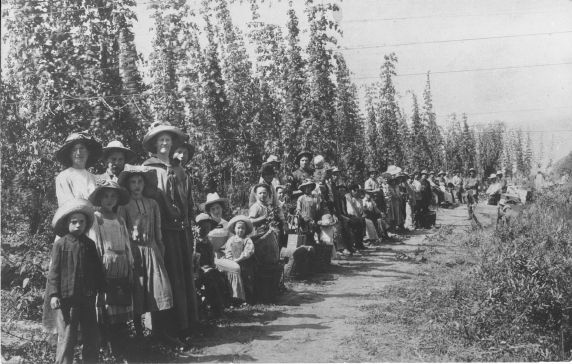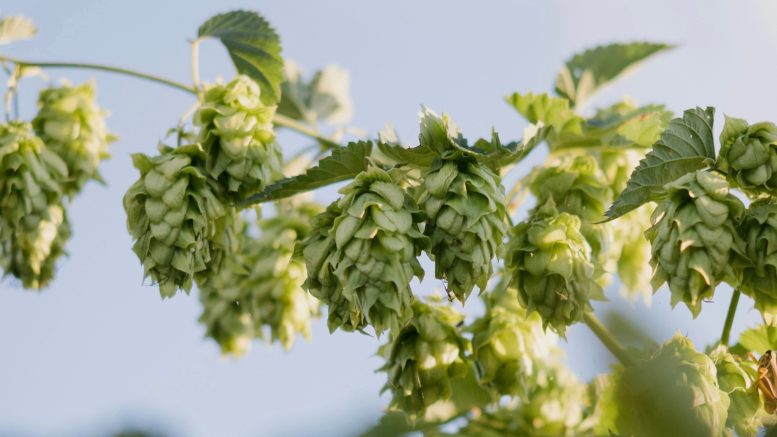By David A. Kulczyk
The summer of 1913 was one of the hottest summers in California history. On July 10, the thermometer hit 134 degrees Fahrenheit in Death Valley, the hottest recorded temperature in the United States. More than 400 miles northwest, the Sacramento Valley was as hot as a pizza oven, but the stifling heat didn’t discourage thousands of agricultural workers to work the three-week harvest in the vast hop fields. Little did the temporary workers know how much hotter the hop fields were about to become.
Hops are a creeping flower used as a flavoring and stability agent in beer. There is no major commercial use for the plant other than in the production of beer. A close relative of hemp, hops are grown on specially prepared fences and reach up to 30-feet tall by harvest time. Only the female flowers are harvested. Before mechanization, hop harvesting was a labor-intensive and dirty job, and harvest occurred only during a three-to four-week window. Hop farmers hired as many workers as possible to ensure that the harvest was brought in on time and the wages were kept low. Pickers worked from sunrise to sunset and sometimes even at night.
In 1913, the largest hop farm in the world was the Durst Brothers Hop Yard outside of Wheatland in Yuba County. The Durst Brothers knew their business well and had long arranged that their 640 acres of hops be sold to a single brewer in England. Only the finest hop cones were picked at the Durst Brothers’ farm. Drying and packaging were done on site in hop kilns before the product was transported on special trains to ships docked in the San Francisco Bay for the long voyage to England. The Durst Brothers were at the time the single largest employer of agricultural workers in California.
They had hired a German foreman who had new ideas on how to streamline production and maximize profit. First, he got rid of the “high pole men,” young and athletic types who climbed 30 feet up the hop vines to detach the vines from the support fence for the pickers below. The high pole men’s other duties were to carry, weigh and load the hops onto a wagon. As a result of this cost cutting, women and children had to reach the hops, no matter how high they were. The pickers then had to carry their own hopsacks, which generally weighed 100 pounds, to the scales and load them onto the transport wagon. This lessened the time that the worker could be picking and earning money.
If climbing 30 feet up rickety poles, hauling, weighing and loading 100-pound sacks wasn’t enough, the Durst Brothers also saved money by not providing fresh water to their workers in the fields. They instead charged five cents a glass for a mixture of water and acetic acid, a liquid compound found in vinegar and used in the production of paint solvents. Food had to be bought at Durst’s company store where the costs were high and the quality low. Sanitary conditions at the dusty workers’ camp were nonexistent. The water in the nearby irrigation canals was contaminated and undrinkable. There were only nine doorless outhouses provided at the camp and none were provided in the fields. Garbage was tossed into ditches and irrigation canals. Dysentery quickly spread through the campground. In the 100-degree heat, the stench was appalling.

To keep the pickers for the entire 18- to 20-day harvest, the Durst Brothers inaugurated a bonus system that was only a bonus to the brothers. The going rate for picking hops in 1913 was $1 for every 100 pounds of hops. Under their idea of a bonus system, the Dursts paid 90 cents per 100 pounds the first week, $1 per 100 pounds the second week and $1.10 for a 100-pound sack during week three. The idea was to keep the pickers in the Durst fields for the entire season, but it was also estimated that the brothers profited $100 a day in wage holdbacks forfeited by pickers who left before the season was over.
On August 1, 1913, about 3,000 people signed up to work the Durst ranch harvest, about twice as many as needed as the drying ovens only had the capacity to process the output of 1,500 pickers a day. Ranch manager Ralph H. Durst was following the common practice of advertising for more workers than he really needed to ensure that the crop was brought in on time.
By the evening of day two of the harvest, 1,700 workers held an informal meeting. Durst pickers came from more than 25 different nationalities, and among them were a couple of dozen members of the Industrial Workers of the World, also known as Wobblies. Richard “Blackie” Ford, an articulate and experienced organizer, was among the IWW members.
The workers formed a grievance committee and elected leaders to notify the Dursts of their demands for a flat rate of $1.25 per 100-pound hopsack. They would also demand fresh ice water in the fields three times a day, sanitary toilets, garbage collection and the rehiring of the “high pole men.”
The next day the grievance committee, led by Blackie Ford, along with 400 to 500 pickers and 30 battle-experienced Wobblies, assembled at the dance platform a half mile from the company office. They marched in columns of four to the hop yard’s headquarters. When Ralph Durst came out of his office, a halt was called to the marchers and the grievance was read to Durst. To his credit, Durst listened to the demands and asked for an hour to think it over. The grievance committee gave him two hours.
A rat-faced, derby-wearing, cigar-chomping manager, Durst halfheartedly agreed to all demands except the wage increase. When told by Ford that there would be a strike, Durst charged at him and slapped him across the face with a heavy work glove. He then ordered him and the other marchers off his property. They refused to leave.
Durst went off to Wheatland to get the police and his attorney, Edmund Tecumseh Manwell, who just happened to be the district attorney of Yuba County. Manwell, Yuba County Sheriff George H. Voss, and constables L.B. Anderson, Elmer Bradshaw, Henry Daken and Eugene Reardon joined Durst to evict the protesters. Sheriff Voss had deputized Anderson, Daken and Reardon before they drove out to the Durst yards. Reardon was a 67-year-old, Red Bluff sheep shearer who in his younger days was a renowned Indian fighter. He was on his way to work in Sutter County when Sheriff Voss asked him to join the posse.
The posse spotted the protesters at the dance platform and roared up in their auto to confront them. Firing his pistol into the air for emphasis, Voss yelled to the crowd, “I’m the sheriff of Yuba County! Disperse!” But the workers stood their ground and a rock was thrown, striking Sheriff Voss in the head. Walking through the crowd, the authorities nervously eyed the protesters milling about the dance floor when Ralph Durst spotted Ford. Durst pointed at Ford and yelled to the posse, “That’s the man! Take him!” As the officers grabbed Ford, the crowd surged forward and all hell broke out.
The crowd grabbed Sheriff Voss, took his weapons and beat him to the ground as Deputy Daken fired his sawed-off shotgun into the air. Deputy Reardon pulled out his pistol, but an African-American picker grabbed his arm and grappled with the old Indian killer. The gun went off wildly several times as the men struggled. Finally, the striker wrenched the pistol from Reardon’s hand and beat him over the head with it.
District Attorney Manwell rushed up to the fallen officers and was shot in the heart by the African-American. Conflicting articles in the Sacramento Bee reported that Ralph Durst shot the African-American in the chest, “creating a hole behind his left nipple large enough to drop a hen’s egg into,” but Deputy Daken later took credit for the kill. It is known that Durst and his guards fired indiscriminately into the crowd until their guns were empty.
Jumping into their car, Durst and his goons retreated to the farmhouse, leaving the officers to fend for themselves. The crowd beat Deputy Daken until he broke away and ran for the company store. Once inside, he shaved off his mustache, threw out his false teeth and darkened his face to disguise himself from the searching rioters. Posing as a company bookkeeper, Daken fooled the mob and made his escape at sunset.
When the gunsmoke cleared, District Attorney Manwell, Deputy Reardon, the unidentified African-American and 18-year-old Sacramento picker Ed Donnelly, who apparently worked at a different hop farm and was an innocent bystander, all laid dead. Deputy Anderson received a severe scalp wound and was shot in the arm. Sheriff Voss was beaten bloody and left with a broken left leg. Deputy Bradshaw was shot in the elbow. Nels Nelson, a Durst goon, had his right arm shattered by a shotgun blast. It was reported that many protesters were injured, including two women and a boy who were secreted away by the pickers.
Fearing retribution, hundreds of Durst farm pickers packed up as fast as they could and scrambled away from the campground, seeking work at more humane hop yards or catching the first train out of Yuba County. The police put up a dragnet and caught Ford along with other suspected Wobblies. Fearing gangs of Wobblies from all over the west would descend on the hop farms of Yuba County, Governor Hiram W. Johnson called out the state’s militia to keep the peace in Wheatland. The IWW invasion never materialized, and the militia was sent home by August 9.
The Durst Brothers ended up giving in to the protesters’ demands, and fresh ice water was provided in the field, garbage was collected, more outhouses were provided in the campgrounds and in the fields, the use of high pole men was reinstituted and the pickers were paid a flat rate of $1 per 100 pounds.
Ford and another IWW leader, Herman Suhr, who wasn’t present at the riot, eventually were convicted of second-degree murder and sentenced to life imprisonment.
The prosecutor admitted that Ford and Suhr had not taken part in the riot, but argued they were guilty of provoking workers into violence by being IWW members. Their highly publicized trial put a spotlight on the plight of farm workers and many new, but ineffective, laws were put into place to improve conditions and protect workers. Ford and Suhr became labor martyrs and were pardoned in 1925.
Next to an electrical substation and almost surrounded by a chain-link fence, a plaque set on a stone in Wheatland marks the location of the dance platform where the uprising occurred on that hot bloody Sunday. Dedicated in 1988, on the 75th anniversary of the unrest by the Camp Far West Parlor Number 218 N.D.G.W.—Wheatland Historical Society, it erroneously states:
Durst Hop Ranch—
Site of Wheatland Hop Riot
August 3, 1913
Second Major Labor Dispute in the U.S.A.
Initiated by the IWW Labor Movement
It is one rare case in which the losers placed a monument acknowledging defeat.


Be the first to comment on "Hops of Wrath: 1913’s bloody Wheatland Hop Riot eventually led to better conditions for workers"